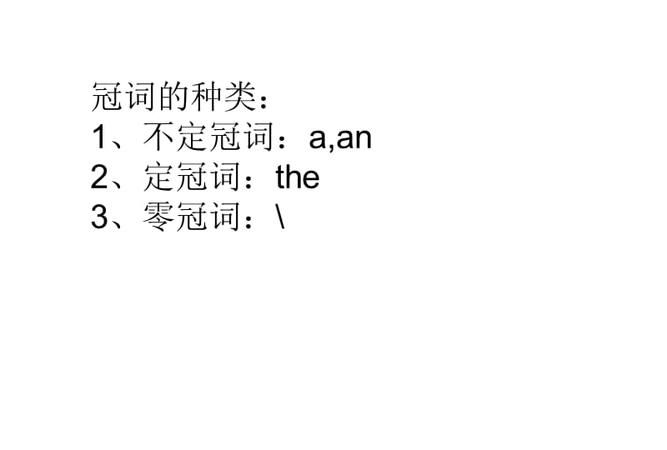本文目录
冠词有哪些英语单词
冠词(Article)是一种虚词,在句子中一般不重读,本身不能独立使用,只能与名词放在一起(一般用于名词之前)帮助说明名词所指的人或事物,包含不定冠词(IndefiniteArticle)、定冠词(DefiniteArticle)、否定冠词(Negativearticle)、部分冠词(Partitivearticle)和零冠词(ZeroArticle,即不用冠词)。在汉语中是没有冠词的。

冠词分类简介
定冠词(例如英语中的the)用来限定这个冠词后面的名词是某个特定的事物;
不定冠词(例如英语中的a/an)用来表示这个冠词后面的名词是指某一类特定事物中的一个,但具体是哪一个并不重要;
部分冠词(例如法语中的du/dela)用来表示这个冠词后面的名词的量是不确定的;

否定冠词(例如德语中的kein)用来表示这个冠词后面的名词是不存在的。
零冠词指的是不用冠词的情况。
此外,在某些语言中(比如法语),同一个名词的阳性与阴性形式,单数与复数形式的读音完全一样,通过前面不同的冠词的使用,可以让听话者区分出这个名词的不同形式。
英语冠词的常见用法归纳详解图片
相信很多人在英语的学习中,语法是一个大问题吧!下面是我归纳的一些关于冠词的常见用法,希望这些冠词英语语法能帮到大家!
英语冠词的常见用法归纳:分类
冠词分为定冠词the和不定冠词a/an
英语冠词的常见用法归纳:不定冠词用法
1.可数名词单数第一次提到。 She is working in a factory.
2.用于人名前,表示说话者对此人不认识或者表示与某名人有类似性质的人或者事物。
A Smith is asking for you outside,.有位叫Smith的人在外面找你。
He wished to become a Newton.
3.用来修饰单位、速度、比率等名词,意为“每一”和per含义相当。
The car is running 80 miles an hour.
4.用在序数词前,表示“又一、再一”的含义。
When I sat down, a fourth man stood up to speak.
我刚坐下,又有一个人来跟我说话。
5.用在of+a(n)+n.可以限制类别或者数量的名次结构中,表示“同一、相同”时=the same.
We are of an age.=We re of the same age.
6.用在具体化的抽象名词前,表示“一个人”或“一件事”。
My family is a failure in life.
7.用在表示世界上独一无二有形容词修饰的名词前。
Everybody wishes to live in a peaceful world.
8.当表示“季节、月份、日期、三餐”的名词前有形容词修饰时。
We really had a wonderful breakfast this morning.
9.用于固定搭配,表示“许多、大量”
have a cold/have a fever/all of a sudden/in a hurry/for a while/in a word/have a gift for/have a word with/at a loss/once upon a time
10.有些不可数名词,如knowledge, collection, understanding后面加of时,前面需用不定冠词a/an.
Her new book is a collection of short stories.
11.so/as/too/how+adj.+a/an+可数名词单数
She is as good a student as anybody else.
He doesn’t know how precious a friend is.
12.half/many/quite/rather/such+a/an+adj.+可数名词单数
We have never seen such a beautiful girl before.
英语冠词的常见用法归纳:定冠词的用法
1.用在姓氏复数前,表示一家人。The Greens are at table.
2.用在年代、朝代名词前或用在世纪或逢10的复数年代前。(在某人50多岁时用in ones 50s)
A great many important events took place in the 1900s.
The Tang Dynasty(唐朝)
3.用在表示计量单位的名词前。 Apples are sold by the kilogram.
但如果是单位名词的总称,名词前不用冠词,如:
by weight; by time; by length
Fruit is sold by weight.
4.特指双方都明白的人或者事物。Take the medicine.
5.指上文提到过的人或者事物。He bought a house. I’ve been to the house.
6.指世界上独一无二的事物。
the sun, the Internet, the moon, 但space前没有冠词
7.与形容词或分词连用,表示一类人或者一类事物。
the rich, the wounded, the new
8.用在表示乐器的名词前,但中国乐器前没有定冠词 play the piano, play erhu
9.用在序数词、形容词最高级以及形容词only, very, same前面
She is always the first to come and the last to leave.
10.动词+sb.+介词+the +身体的某一部位
take sb. by the arm 抓住某人的手臂 hit sb. in the face打某人的脸
11.用在the more…,the more…结构中,表示“越……越……”(more指形容词的比较级)
The harder you study, the better you will learn.
12.用在发明物的单数名词前,既表示特指又表示类别。
Bell invented the telephone in 1876.
13.固定 短语
on the whole, in the way, go to the theatre/cinema, to tell the truth, all over the world, in the distance, in the form of
英语冠词的常见用法归纳:零冠词的用法
1.不可数名词、复数名词表示泛指,用零冠词
Father went to his doctor for advice about his heart trouble.
Horses are useful animals.
2.月、季、星期、节假、洲;呼语、头衔、职务前;三餐、球类,惯用语;学科、棋类名词前用零冠词。
He has no lessons on Sundays.
It is usually very cold in winter in the north.
(表示呼语、头衔的名词做表语、同位语、补足语时用零冠词)
注意:如果表示“某个”应用不定冠词;表示特指应用定冠词。
I am not exactly sure when he returned but I’m sure that he returned on a Monday.
The winter of last year was extremely cold.
3.在独立主格结构中“名词+介词+名词”中的名词前
The teacher is standing in the front of the classroom, book in hand.
4.turn, go做系动词,表示“变为、成为” 时,后接可数名词单数做表语,不定冠词要省略。
She turned teacher ten years ago.
=she became a teacher ten years ago.
5.in+书写工具或者颜料
You can never write your composition in red.
6.“零冠词+单数名词+as/though+主语+谓语” 虽然/尽管……,但是……
Hero as he is, he has some shortcomings.
7.固定短语
At home, at first, on condition that, in charge of, in danger, in spite of, out of breath
英语冠词的常见用法归纳:冠词易混点
1.抽象名词具体化时,被具体化的名词与a/an连用。
A heavy rain, a surprise, a success/failure
2.形容词比较级前加the表示“两者中较……的”
形容词最高级前加a或者an,没有比较含义
Which is the larger country, Canda or America?
It is a most useful book.
3.“the+序数词”表示排序
“a/an+序数词”表示“又一、再一”
Can you give me a second chance?
4.纯不可数名词,没有冠词。
weather, fun, advice, word(news), progress, information, news
猜你喜欢:
1. 冠词语法讲解及练习题
2. 高考英语易错题之冠词
3. best的用法和短语例句
4. 定冠词the的用法总结
5. 高考英语语法知识总结冠词

冠词的用法和连词的分类归纳
1. 不定冠词的用法
(1) a用在子音前; an用在母音前。
An hour
(2) 表同种类的全体, 此时a带有any的意味。
A dog is a faithful animal. (=Dogs are faithful animals.)
(3) 等于one。
I have a sister and two brothers.
(4) 等于the same.
Birds of a feather flock together.
(5) 等于per“每一......”。
We work eight hours a day. Ninety miles an hour.
(6) a = a certain, 表说话者不认识此人。
Do you know a Mr. Smith?
(7) 物质名词或抽象名词加a (an)即成普通名词,
Asparagus is a grass. (a = a kind of).
This is a good cloth for summer.
(8) “have (or take) a 抽象名词”,与抽象名词的动词形同义。
Let us take am. = Let usm.
2. 定冠词的用法
(1) 由于上下文的关系, 某名词所指的东西已非常明显, 或已有一定的范围, 该名词应加the。
Shut the door.
Please pass me the caster.
(2) 表该名词的总称。
The cow is a useful animal. (= Cows are useful animals.)
(3) 前面已提过的名词,再度提到时前面加the。
Once upon a time there was a little boy who lived in a cottage.
The cottage was in the country, and the boy lived there all his life.
(4) 用于为片语或子句所修饰的名词之前。
This is the book that I promised to lend you.
(5) 用在宇宙(独一无二)的天体名词之前。
The sun; the moon; the sky; the earth.
(6) 用在方位,方向等名词之前。
The sun rises in the east and set in the west.
(7) 乐器的名称前要加the。
To play the piano (violin, guitar, flute, etc.)
(8) 表示单位的名词前要加the。
Gasoline is sold by the gallon.
Meat is sold by the catty.
(9) 在最高级的形容词或序数(the first...)之前要加the。
Taiwan is the best place to live in.
(10)专有名词在下列情况可加the。
(A) 海、河、运河的名称:The Thames; the Bahamas;
(B) 复数形的专有名词: The West Indies; the Bahamas;
(C) 船泊的名称: The Queen Mary; the Flying Scotsman; the Comet;
(D) 书报、杂志、经典的名称: the Times; the Central Daily News; the Koran;
(E) 公共建筑、机关的名称: The Ritz Hotel; the Ministry of Education;
(F) 国民的总称: the French; the Japanese; the Chinese;
(G) 用在姓氏的复数前指其全家人: The Chens will move to the country. 零冠词是指名词前面没有不定冠词、定冠词,也没有其他限定词的现象,零冠词的用法如下:
1.表示抽象概括意义时,不可数名词和复数名词使用零冠词,例:
Books are my best friends.
书是我的好朋友。Water boils at 100℃.
水在摄氏100度沸腾。
比较: The water in this river is undrinkable.这条河的水不可饮用。
2.专有名词通常使用零冠词,例:
Lu Xun is a great Chinese writer.
鲁迅是一位伟大的中国作家。
London is the capital of England.
伦敦是英国的首都。
China is a developing socialist country.中国是一个发展中的社会主义国家。
3.按照习惯下列各类名词使用零冠词
1)季节、月份、星期以及节假日等名词,例:Summer begins in June in this part of the country.这个地区夏天从六月份开始。
We have no classes on Sunday.
星期日我们不上课。
There are a lot of people shopping at Christmas.在圣诞节有很多人购买东西。
2)三餐饭菜的名词,例:
have supper 吃晚饭
come to dinner 去吃饭
3)语言、运动、游戏等名词,例:
She speaks Chinese.她说汉语。
He plays football.他踢足球。
Let’s have a game of chess.咱俩下盘棋吧。4)在某些意义有改变的名词前要使用零冠词,例:He has gone to school.(to learn)
他去上学了。
They are in church just now.(to worship)
现在他们在做礼拜。
同样, in hospital是“住院(治疗)”,in prison是“服刑”,等等。
注意:如果在这类名词前加冠词,则表示去那里干与之无关的事,例:
go to the school可理解为去学校看望人,而不是“学习”。
4.在表示职位、头衔、身份等名词前,例:
Professor Wang 王教授
Doctor Tompson 汤普生医生
President Lincoln 林肯总统
Dean of the English Department 英语系主任

英语冠词的用法总结思维导图
冠词是一种虚词,用在名词或名词词组的前面,表示名词是特指还是泛指。
定冠词的用法:定冠词特指某些人或者某些事物, 用以区别于同类中其他的人或事物。 定冠词用于表示世界上独一无二的事物,或者用于自然界现象或方位名词之前。 定冠词与单数名词连用,表示这一类人或物。
不定冠词的用法:不定冠词用来指某人某物,但不具体说明任何人或任何物。表示人或事物的某一种类,强调整体, 即以其中的一个代表一类。 零冠词的用法:表示抽象概括意义时,不可数名词和复数名词使用零冠词。专有名词通常使用零冠词。

分类:
冠词分为不定冠词、定冠词、否定冠词、部分冠词和零冠词,零冠词指的是不用冠词的情况。
定冠词(例如英语中的the)用来限定这个冠词后面的名词是某个特定的事物。
不定冠词(例如英语中的a/an)用来表示这个冠词后面的名词是指某一类特定事物中的一个,但具体是哪一个并不重要。
部分冠词(例如法语中的du/de la)用来表示这个冠词后面的名词的量是不确定的。
否定冠词(例如德语中的kein)用来表示这个冠词后面的名词是不存在的。
此外,在某些语言中(比如法语),同一个名词的阳性与阴性形式,单数与复数形式的读音完全一样,通过前面不同的冠词的使用,可以让听话者区分出这个名词的不同形式。
以上就是关于冠词的分类及用法总结 ,冠词有哪些英语单词的全部内容,以及冠词的分类及用法总结 的相关内容,希望能够帮到您。
